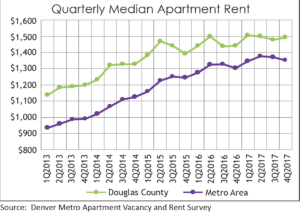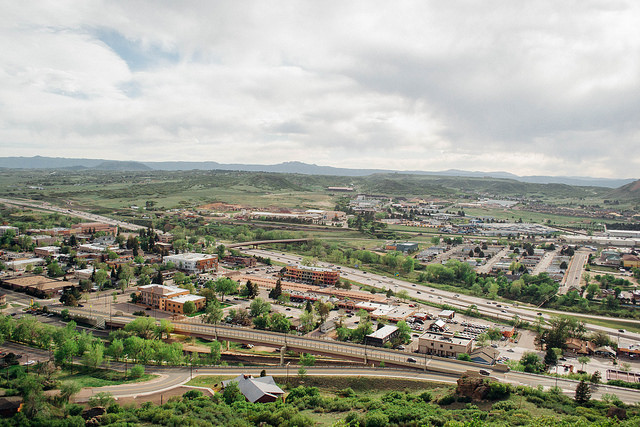Deliberate Efforts to Bring Affordable Housing to a Colorado Exurb
Affordable housing has become a significant issue in all corners of America, from big and small cities to rural areas. The problem also touches Douglas County, a fast-growing Exurb south of Denver, where income and education levels — crucial social and economic factors of health — run near the top of the Census charts.
Here the median price of all homes sold was $456,013 in the third quarter of 2017, a price point out of reach for many. Teachers, police officers and retail workers often struggle to find a place to live in Douglas, and studies show the need for affordable housing units is about 5,000 more units than currently exist in the county.

The Douglas County Housing Partnership is steadily working to narrow this large gap. “Ideally we will develop an average of 200 affordable rental units per year in the next five years as well as assist an additional 20 low-income households achieve the dream of home ownership each year,” says Program Manager Artie Lehl.
There’s much that communities can learn from the progress in Douglas where severe housing problems stand at 11%, lower than the Exurbs’ average rate of 14%, according to the American Communities Project’s analysis of the 2018 County Health Rankings. The national average is notably higher at 19%. Severe housing problems are defined as the percentage of households with at least one or more of the following housing problems: unit lacks complete kitchen facilities; unit lacks complete plumbing facilities; household is severely overcrowded; or household is severely cost burdened. Severe housing problems in Exurban counties span from 8% to 25%. Of America’s 222 Exurbs, just 12 sit above the national average.
Lehl recently shared his team’s work with the American Communities Project, including what other Exurbs can apply from their missteps and successes.
Outlining Housing Trends and Needs
With home prices and apartment rents continuing to rise, the demand for affordable/attainable housing is at an all-time high in the Denver metro area. More resources to assist those of us working to develop affordable units are being made available. For its part, Douglas County is even changing zoning regulations in some areas to allow for Accessory Dwelling Units and more multi-family and senior housing.

At the same time, Colorado needs about three times the amount of 9% Low-Income Housing Tax Credits (LIHTC) than it is currently entitled to. This would allow areas such as Douglas County to have a better chance to develop much-needed senior housing.
Workforce housing developers in Douglas County would also be more productive if the county was entitled to about 50% more Private Activity Bond Cap. This works in that we are the issuer of the tax-exempt bond cap, and the developers that use it are entitled to non-competitive 4% Low-Income Housing Tax Credits. If we had about 50% more cap, we could move forward one more project each year.
Culling and Cultivating Sources
Census Bureau and County Demographic reports provide us with the greatest amount of data to help us drive our programs and developments. We look for information and feedback from the county’s needs assessments. The last assessment from 2013 said we need 3,000–4,000 additional low-income rental units and 2,500–5,000 units for attainable homeownership. Also meeting with our local coalition of nonprofits to get a ground-level understanding of the needs and the challenges they and their clients are facing further enhances our work.
Shifting Hearts and Minds
Business leaders in Douglas County understand the value and importance of the development of affordable housing. We are relying on these leaders to help turn the hearts and minds of those who oppose affordable housing. The issue of NIMBYism [Not In My Backyard] comes mostly from the public. We are also committed to educating the public and take advantage of every opportunity to speak about this in public.
Working Together
We have a number of working groups with all of our counterparts in other jurisdictions, such as the Douglas County Community of Cares Coalition, Housing Colorado, the Colorado Housing Counseling Coalition, and the National Association of Housing and Rehabilitation Officials. We network diligently with each other so we are all gleaning what we can to be more successful throughout Colorado.
Building Partnerships
Our partnerships are built in a variety of ways, but the most common begins with a referral from the various planning departments within Douglas County. Developers of all types of housing always begin their process by reaching out to the local planners, and through our outreach efforts, these planners are aware that we have something to offer developers. They simply refer the developer to us and the partnership builds from there. We have a number of incentives that we can provide developers to assist them in creating more financially feasible projects with greater affordability, such as Private Activity Bonds, lower closing costs and tax abatement.
A Sterling Example
The most successful partnership we have cultivated to date is with Shea Properties, a division of the J.F. Shea Corporation (the same corporation responsible for the construction of the Golden Gate Bridge and the Hoover Dam). Shea Properties develops, holds and operates multi-family and commercial real estate.
Several years ago, Shea was prodded by the county to develop affordable workforce housing in one of its largest office parks. Rather than outsource the project, Shea took it on and was referred to our agency for support. Its very first Low-Income Tax Credit project in Colorado was here in Douglas County. Apex Meridian opened in late 2014 and has become so successful that it is the model LIHTC development for the county. We are about to begin a second phase of the project in the next couple of months. And we have commitments from Shea for as many as three more projects in the coming years.

Calculating Missteps
One of our greatest setbacks was miscalculating the strength of NIMBYism in certain communities. We had two projects proposed in the town of Parker last year, one of which required re-zoning. We were confident that local officials would ignore any outcry against the naysayers, and we also underestimated how large and organized our opposition would become. The project requiring rezoning was denied. The other project that was approved, as it was zoned properly, has faced legal challenges.
Learning from Experience
Because of these missteps we have been much more cautious about land selection and making sure that we have gone above and beyond to create amazing communication with our neighbors and the local community. We now work to find community leaders to meet with one-on-one, as well as make sure to talk directly to all neighbors within a half mile of our projects before we even host a single community gathering. We are also tied in to local community social media pages. This has helped to alleviate any negative sentiment before it spreads.
Our most recent development proposed in Castle Rock, the county seat, thusly had almost no negative feedback and will be under construction within a year. This development is an extension of our Oakwood Apartments and will add 45 new units for low-income seniors.
Drawing Inspiration
Our inspiration comes from our success stories. Every time we help turn someone’s life around, or give them a leg up or just help them find housing that fits their needs and their budget, it fills us with energy to go and do more!
Read more about Douglas County, Colorado, in the American Communities Project’s October report “Health and Place in America, 2018.”
